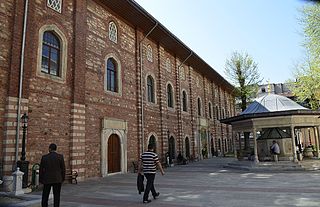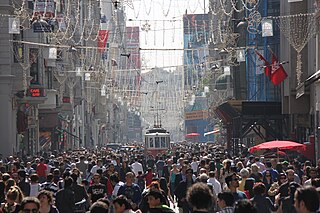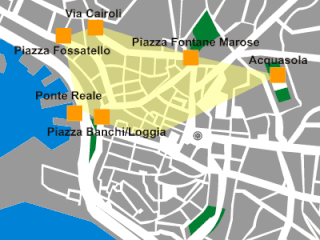
Arap Mosque is a mosque in the Karaköy quarter of Istanbul, Turkey. The building was originally a Roman Catholic church erected in 1325 by the friars of the Dominican Order, near or above an earlier chapel dedicated to Saint Paul in 1233. Although the structure was altered during the Ottoman period, it is the only example of medieval religious Gothic Architecture remaining in Istanbul.

Beyoğlu is a district on the European side of İstanbul, Turkey, separated from the old city by the Golden Horn. It was known as Pera during the Middle Ages.
L'Esposizione Internazionale Specializzata Genova '92 - Colombo '92 or more informally Expo 1992, held in Genoa, Italy from 15 May to 15 August 1992. The theme was "Christopher Columbus, The Ship and the Sea", and the Expo was timed to celebrate the 500 years since the Discovery of America by the Genoese sailor Christopher Columbus. Because of the theme, the expo was also known as Colombiadi. It was a specialized Exhibition with 54 countries represented. Total visitors were 694,800. Although not related, the exposition ran at the same time as Seville Expo '92. The expo's logo was a "500" number with the Genoa's flag; the mascot was a cat dressed like Christopher Columbus called "Gatto Cristoforo"

Genoa Cathedral, Cathedral of Saint Lawrence is a Roman Catholic cathedral in the Italian city of Genoa. It is dedicated to Saint Lawrence, and is the seat of the Archbishop of Genoa. The cathedral was consecrated by Pope Gelasius II in 1118 and was built between the twelfth century and the fourteenth century as fundamentally a medieval building, with some later additions. Secondary naves and side covers are of Romanesque style and the main facade is Gothic from the early thirteenth century, while capitals and columns with interior corridors date from the early fourteenth century. The bell tower and dome were built in the sixteenth century.

Karaköy, the modern name for ancient Galata, is a commercial quarter in the Beyoğlu district of Istanbul, Turkey, located at the northern part of the Golden Horn mouth on the European side of Bosphorus.

The Lighthouse of Genoa, is the main lighthouse for the city's port. Besides being an important aid to night navigation in the vicinity, the tower serves as a symbol and a landmark for the City of Genoa. Built of masonry, at 249 feet (76 m) it is the world's fifth tallest lighthouse and the second tallest "traditional" one. Between 1543 and the construction of the lighthouse on Île Vierge, France in 1902, it was the tallest lighthouse in the world. When measured as a whole with the natural rock on which it stands, as it is commonly perceived and represented, its height is 383 feet (117 m), which would make it the second tallest lighthouse in the world, the tallest in Europe, and the tallest traditional lighthouse.

The Genoa–Pisa railway is one of the trunk lines of the Italian railway network. It runs along the Ligurian coast from Genoa to Pisa through the Riviera di Levante and the Versilia. It passes through the cities of Massa, Carrara and La Spezia. South of Pisa the Pisa–Rome line continues along the Tyrrhenian coast to Rome. The line is double track and is fully electrified at 3,000 V DC. Passenger traffic is managed by Trenitalia.

Monte delle Figne is a mountain in Liguria, northern Italy, part of the Ligurian Appennines. It lies at an altitude of 1172 metres.

The Genoa International Boat Show is one of the world's premier boat shows, held annually in Genoa, Italy, typically during the month of October. The exhibition is organised by Fiera di Genova SpA and UCINA, Italy's professional association of the yachting industry, and takes place at Fieristico as well as parts of the old town and port of Genoa.

The colonies of the Republic of Genoa were a series of economic and trade posts in the Mediterranean and Black Seas. Some of them had been established directly under the patronage of the republican authorities to support the economy of the local merchants, while others originated as feudal possessions of Genoese nobles, or had been founded by powerful private institutions, such as the Bank of Saint George.

Ottone Rosai (1895–1957) was an Italian painter born in Florence.

The Milan International was a world's fair held in Milan in 1906 titled L'Esposizione Internazionale del Sempione, or sometimes The Great Expo of Work. It received 4,012,776 visits and covered 250 acres.
The following is a timeline of the history of the city of Genoa, Liguria, Italy.

Saint Benoit is a Roman Catholic Church in Istanbul, Turkey, important for historical reasons. Established in 1427, the shrine is the oldest Catholic church of Istanbul still in use.
Luigi De Servi was a French-Italian painter active mainly painting sacred subjects in a late-Mannerist style in Siena, Tuscany, Italy.

Maddalena is a neighbourhood in the old town of the Italian city of Genoa. It was one of the six sestieri of ancient Genoa. At present it is part of the Genoa's city Municipio I.

The Genoese Navy, also known as the Genoese Fleet, was the naval contingent of the Republic of Genoa's military. From the 11th century onward the Genoese navy protected the interests of the republic and projected its power throughout the Mediterranean Sea. The navy declined in power after the 16th century, periodically coming under the control of foreign powers, and was finally disbanded following the annexation of Genoa by the Kingdom of Sardinia-Piedmont in 1815.





















